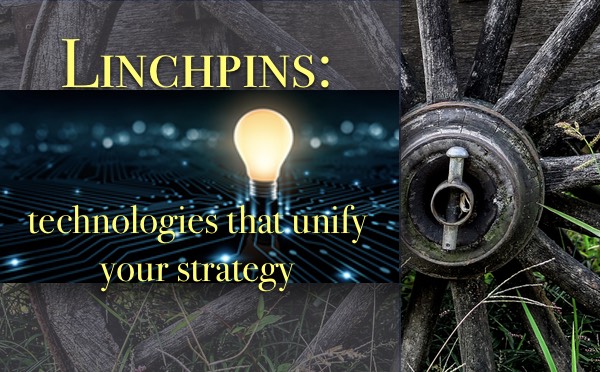When you’re identifying what digital interpretive tactics work for your organization, eventually you will find one (or a combination of a few) that achieves a number of needs. This is called a strategic linchpin.
Linchpins are the result of beginning the strategic process, engaging experimentally, and giving your plans some time to percolate. The ability to focus more effort on fewer linchpin technologies is a sign that your tactical planning has truly become strategic.
The following are three examples of strategic linchpins specific to points-in-time and cultural organizations from my work in digital initiatives.
Strategic Linchpin 1: NCPTT Podcast
In 2007, the National Center for Preservation Technology and Training faced the difficulty of being a National Park Service agency with a mandate to serve a national audience, despite a decade of flat budgets and a relatively remote location in northwest Louisiana. The organization needed a way to show its impact, including the influence of innovative grant projects it funded to support the use of technology for historic preservation purposes. At the time, many of its audiences were cautiously curious about social and online media technologies. Part of this was that there were not really any topically relevant media to compel their participation.

I started the Preservation Technology Podcast as a way to empower staff to showcase their successes, and for audiences to connect to a wider world of like-minded preservation geeks. For all, it was a first step into modern online media, short of the engagement platforms like Facebook and Twitter, which were still viewed as invasive at the time. The podcast’s objectives included the following:
- Give the staff a voice
- Showcase grant products
- Promote peer research
- Connect with a national audience on no budget
- Encourage adoption of digital media among audiences
- Show digital media leadership within NPS
Almost ten years later, the podcast is the longest-running historic preservation podcast being produced. Moreover, NCPTT is noted for its role in championing digital outreach technologies, especially within the National Park Service.
Discover more about the Preservation Technology podcast
Strategic Linchpin 2: Chemical Heritage Foundation GLAM-Wiki Program

In 2013, the Chemical Heritage Foundation was looking for ways to publicly share its comprehensive collections and research related to the history of chemistry. It used a lower-end collections management system and did not have a public search function enabled. It had narrative histories on its website, but they were difficult to find. At the same time, many staff members expressed frustration about the lack of quality information related to these topics on Wikipedia.
CHF chose to participate in the GLAM-Wiki initiative that helps cultural institutions share their resources with the world through collaborative projects with experienced Wikipedia editors. A Philadelphia-area Wikipedia editor was hired as a Wikipedian-in-Residence. This resulted in staff training on Wikipedia, and a systematic upload of high-quality collections images to WikiMedia Commons, and the creation of a monthly onsite cybercafe that included Wikipedia edit-a-thons.
The Wikipedian-in-Residence position was subsequently funded for a four-year term through a grant with the Beckman Foundation, and the Wikipedia content continues to be a major driver of web traffic to CHF web properties.
- Download the GLAM-Wiki case study
- Bonus linchpin case study: Livestream Interactive Webcast
Strategic Linchpin 3: Vizcaya Museum and Gardens 3D Documentation

In March 2016, I had recently been contracted by Vizcaya Museum and Gardens in Miami, Fl., to give strategic shape to their digital initiatives. I reached out to David Morgan, a former colleague to brainstorm the evolution of a concept with which we had some common experience: 3D documentation. We both worked together several years at the National Park Service National Center for Preservation Technology and Training–an organization at the forefront of innovating technologies for heritage preservation. David has since moved on to become director of the NPS Southeast Archaeological Center in Tallahassee, Fl., and made several introductions to people who performed 3D documentation in Florida.
Vizcaya Museum and Gardens is a historic house museum and formal gardens located on Biscayne Bay in Miami. Its heritage resources are continually threatened from the climate (including sea-level rise) and inclement weather. It is also an extremely popular tourist attraction. Dual-purposing preservation documentation technology with visitor-facing interpretive technologies was an attractive idea for the institution.
Only a few people at the organization were aware of preservation documentation technologies. I wrote an explanatory document in summer 2016 that describes how the tech worked, what the advantages were and what partners could help achieve success (here’s a more general explainer based on that research). Among the benefits outlined were:
- Preserve endangered heritage resources
- Make resources accessible & tell their stories to visitors
- Bridge preservation and interpretive technologies
- Nurture academic/tech partnerships
Vizcaya formed a partnership with the University of Florida to prioritize laser scanning and photogrammetry documentation on resources that were of intense interest, but not accessible to the public. In January of 2017, UF completed scanning of the resources for preservation purposes.
In May 2017, the Knight Foundation awarded Vizcaya a grant for $100,000 to fulfill its vision to create visitor-facing virtual experiences based on 3D documentation of these resources. 3D documentation technology has come a long way in the past five years, and really, only now would we be attempting to make this visitor-facing element happen. This was made evident when I attended NCPTT’s 3D Documentation Summit in April. Many of the speakers there mentioned virtual experiences as the “next phase” of this technology. We’d already submitted our grant idea by then, but it was gratifying to know the leaders in this field were thinking the same way.
It’s been an incredibly rewarding experience seeing the idea take root at Vizcaya, knowing that the resources are being cared for, and the visitor experience as well. The values of Vizcaya’s leadership and staff, and the nature of Vizcaya itself, are what made 3D documentation its first strategic linchpin technology.

